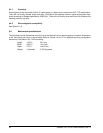
Cheetah 10K.7 SCSI Product Manual, Rev. D 41
7.0 Defect and error management
The drive, as delivered, complies with this specification. The read error rate and specified storage capacity are
not dependent upon use of defect management routines by the host (initiator).
Defect and error management in the SCSI system involves the drive internal defect/error management and
SCSI systems error considerations (errors in communications between Initiator and the drive). Tools for use in
designing a defect/error management plan are briefly outlined in this section, with references to other sections
where further details are given.
7.1 Drive internal defects
During the initial drive format operation at the factory, media defects are identified, tagged as being unusable,
and their locations recorded on the drive primary defects list (referred to as the “P” list and also as the ETF
defect list). At factory format time, these known defects are also reallocated, that is, reassigned to a new place
on the medium and the location listed in the defects reallocation table. The “P” list is not altered after factory
formatting. Locations of defects found and reallocated during error recovery procedures after drive shipment
are listed in the “G” list (defects growth list). The “P” and “G” lists may be referenced by the initiator using the
Read Defect Data command (see the SCSI Interface Product Manual).
7.2 Drive error recovery procedures
Whenever an error occurs during drive operation, the drive, if programmed to do so, performs error recovery
procedures to attempt to recover the data. The error recovery procedures used depend on the options previ-
ously set up in the error recovery parameters mode page. Error recovery and defect management may involve
the use of several SCSI commands, the details of which are described in the SCSI Interface Product Manual.
The drive implements selectable error recovery time limits such as are required in video applications. For addi-
tional information on this, refer to the Error Recovery Page table in the SCSI Interface Product Manual, which
describes the Mode Select/Mode Sense Error Recovery parameters.
The error recovery scheme supported by the drive provides a means to control the total error recovery time for
the entire command in addition to controlling the recovery level for a single LBA. The total amount of time spent
in error recovery for a command can be limited via the Recovery Time Limit bytes in the Error Recovery Mode
Page. The total amount of time spent in error recovery for a single LBA can be limited via the Read Retry
Count or Write Retry Count bytes in the Error Recovery Mode Page.
The drive firmware error recovery algorithms consist of 11 levels for read recoveries and 5 levels for writes.
Table 3 equates the Read and Write Retry Count with the maximum possible recovery time for read and write
recovery of individual LBAs. The times given do not include time taken to perform reallocations, if reallocations
are performed. Reallocations are performed when the ARRE bit (for reads) or AWRE bit (for writes) is one, the
RC bit is zero, and the Recovery Time Limit for the command has not yet been met. Time needed to perform
reallocation is not counted against the Recovery Time Limit.
The Read Continuous (RC) bit, when set to one, requests the disc drive to transfer the requested data length
without adding delays (for retries or ECC correction) that may be required to insure data integrity. The disc
drive may send erroneous data in order to maintain the continuous flow of data. The RC bit should only be


















